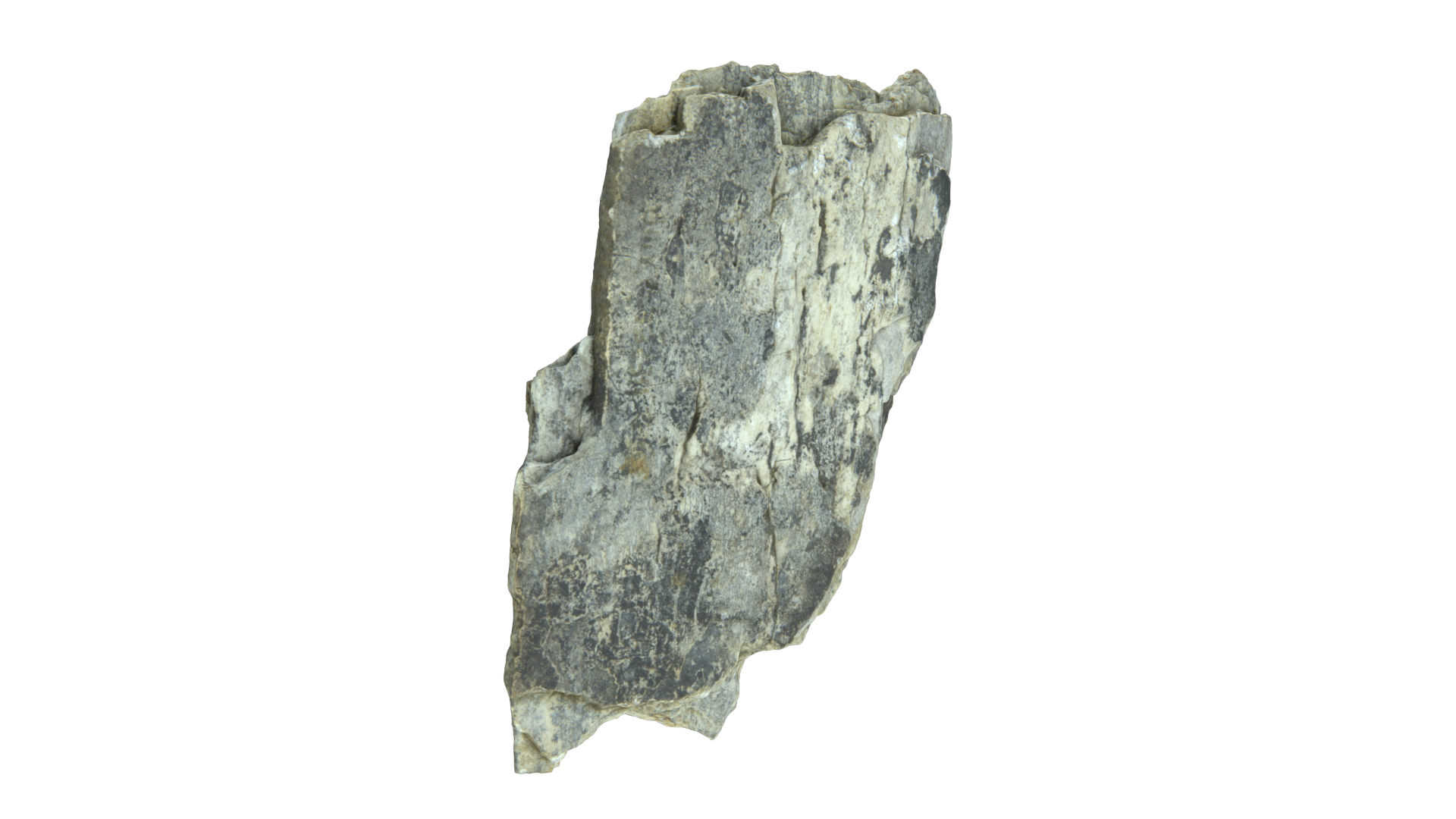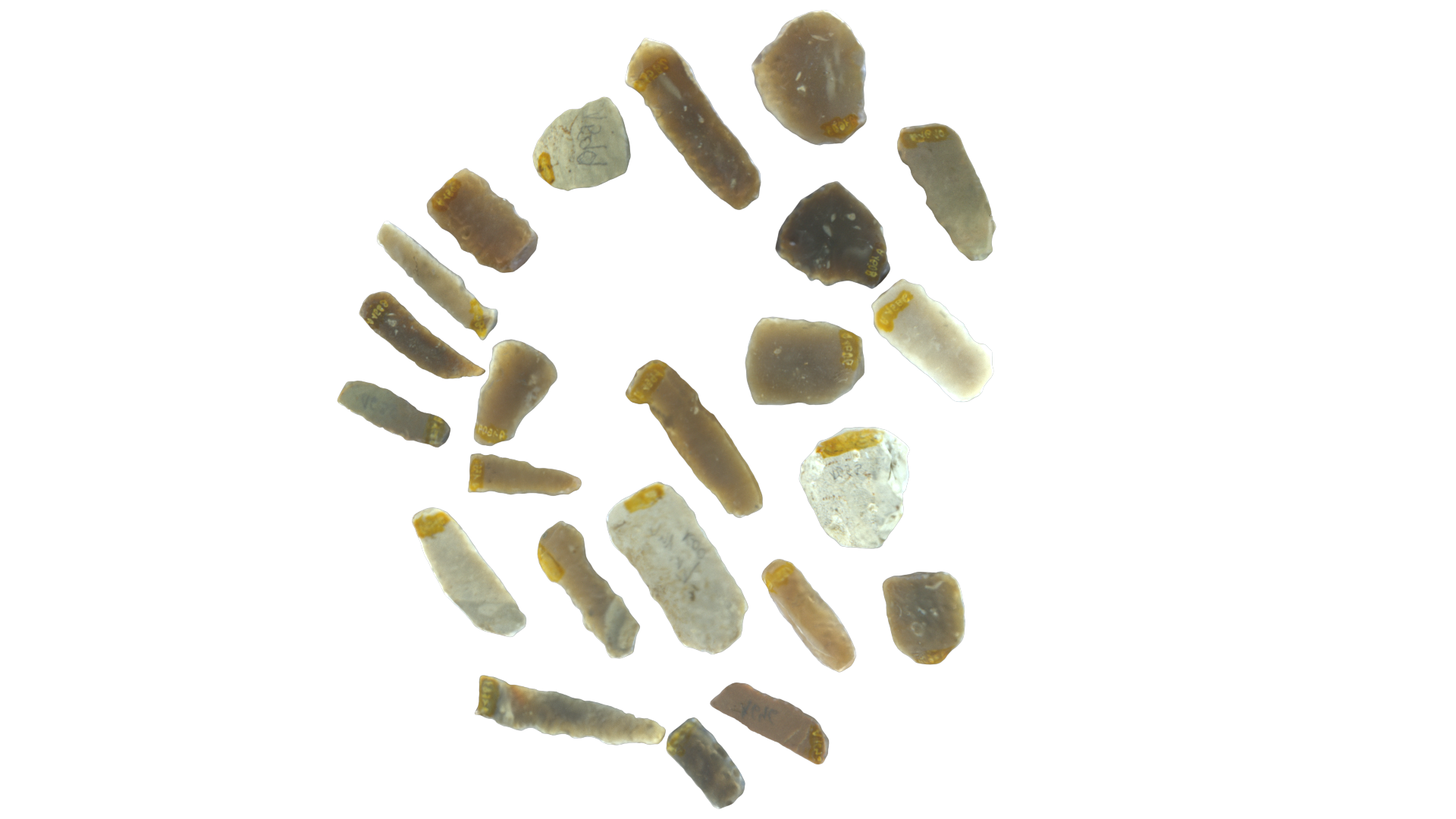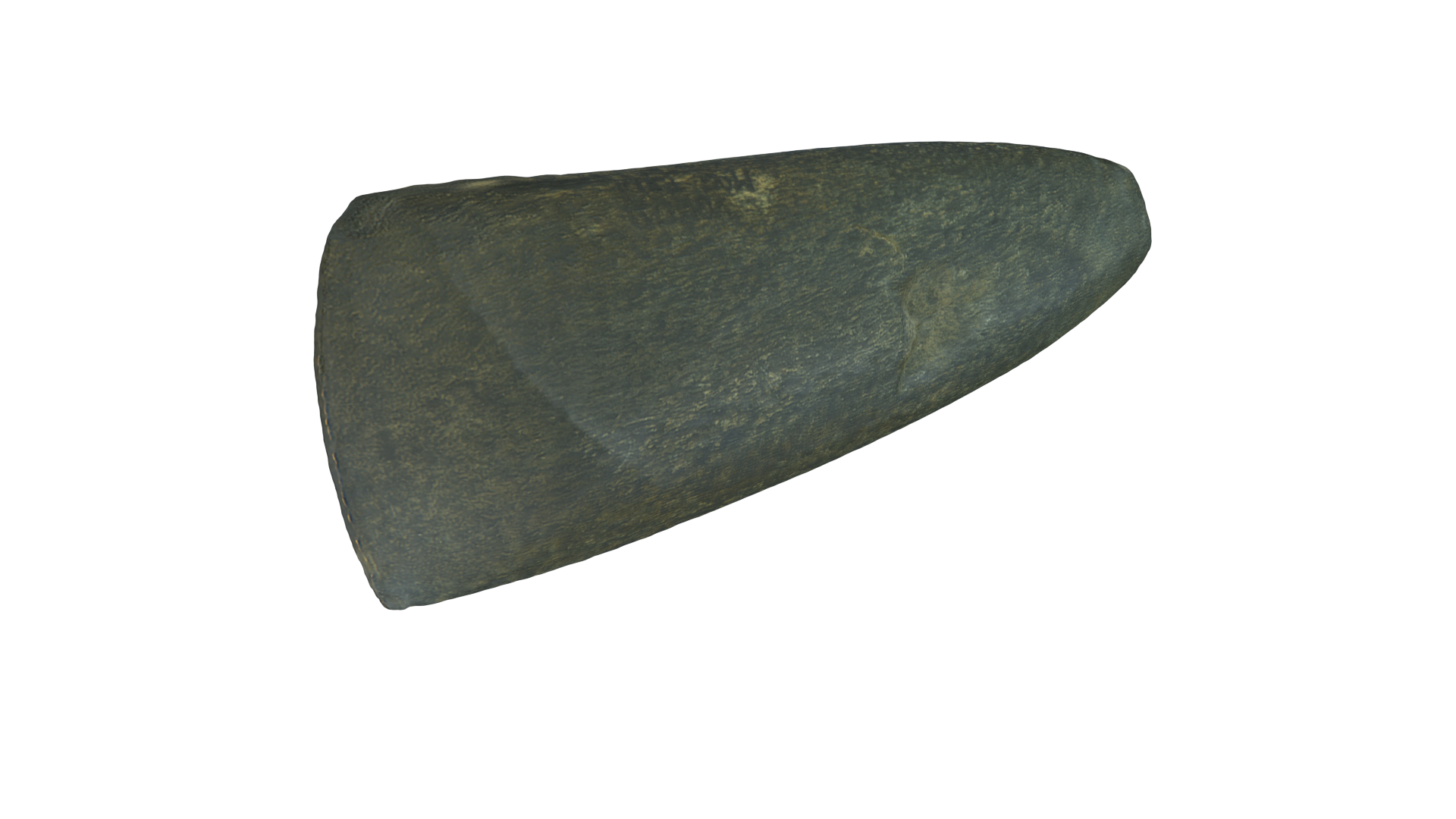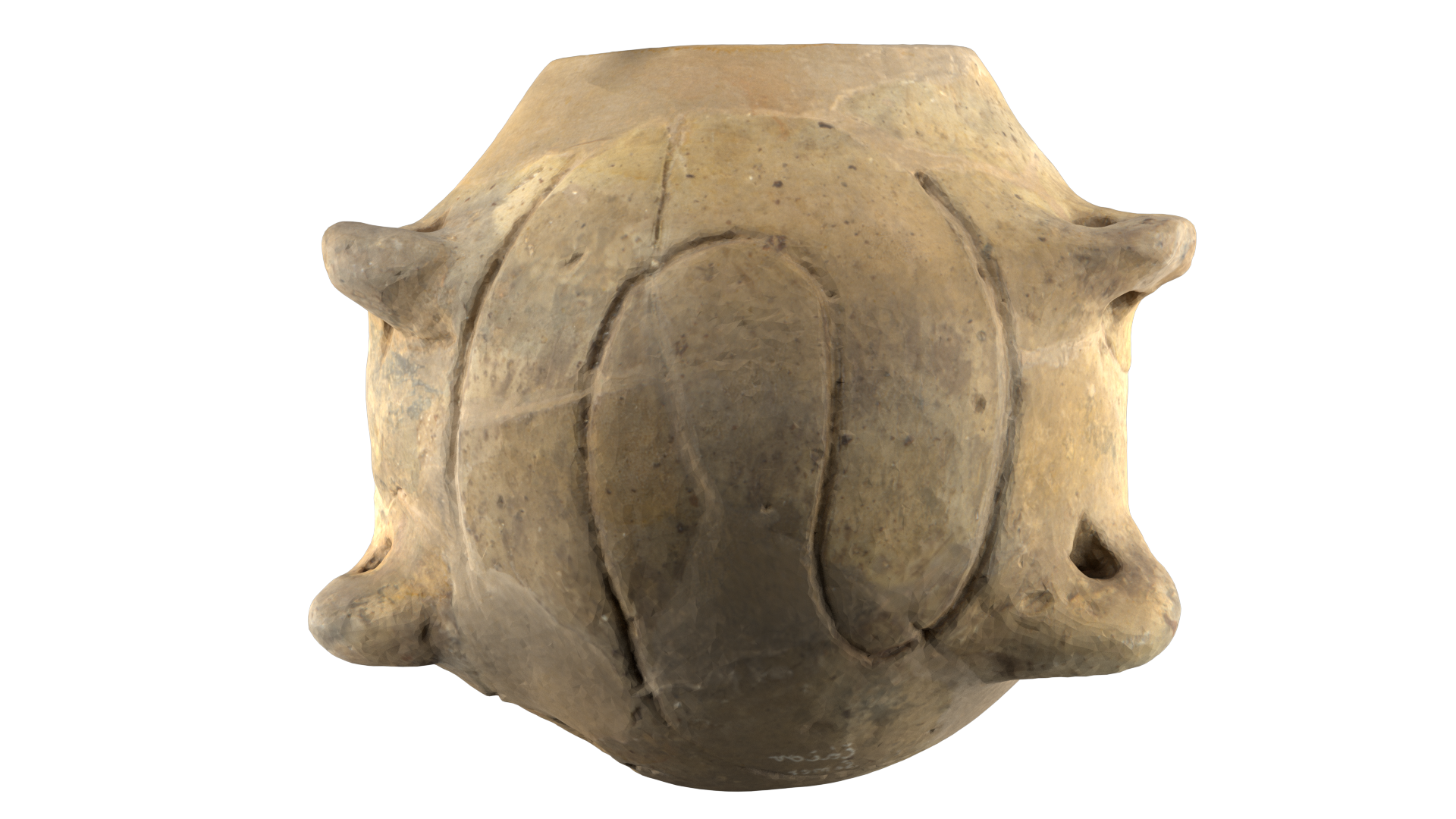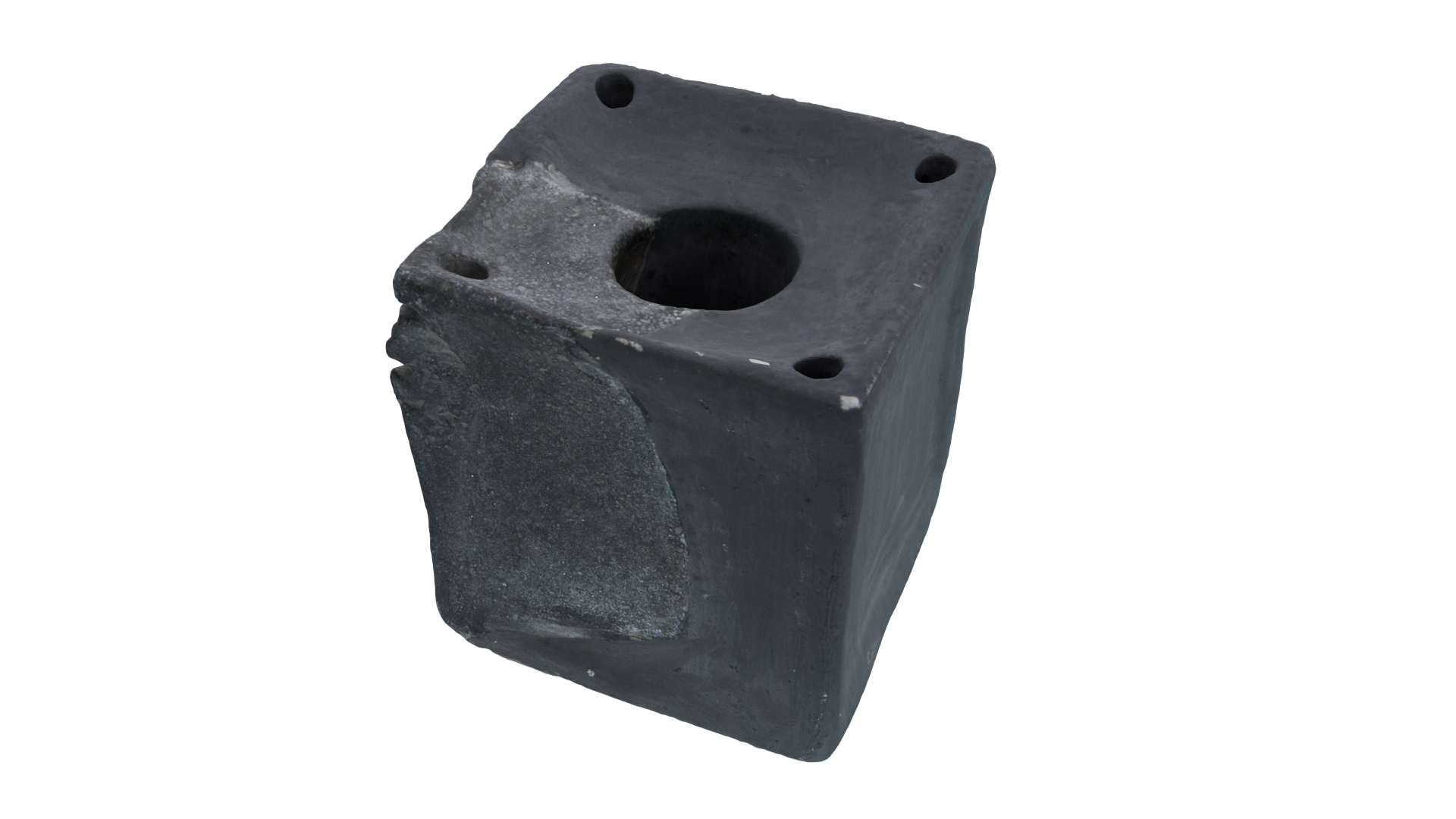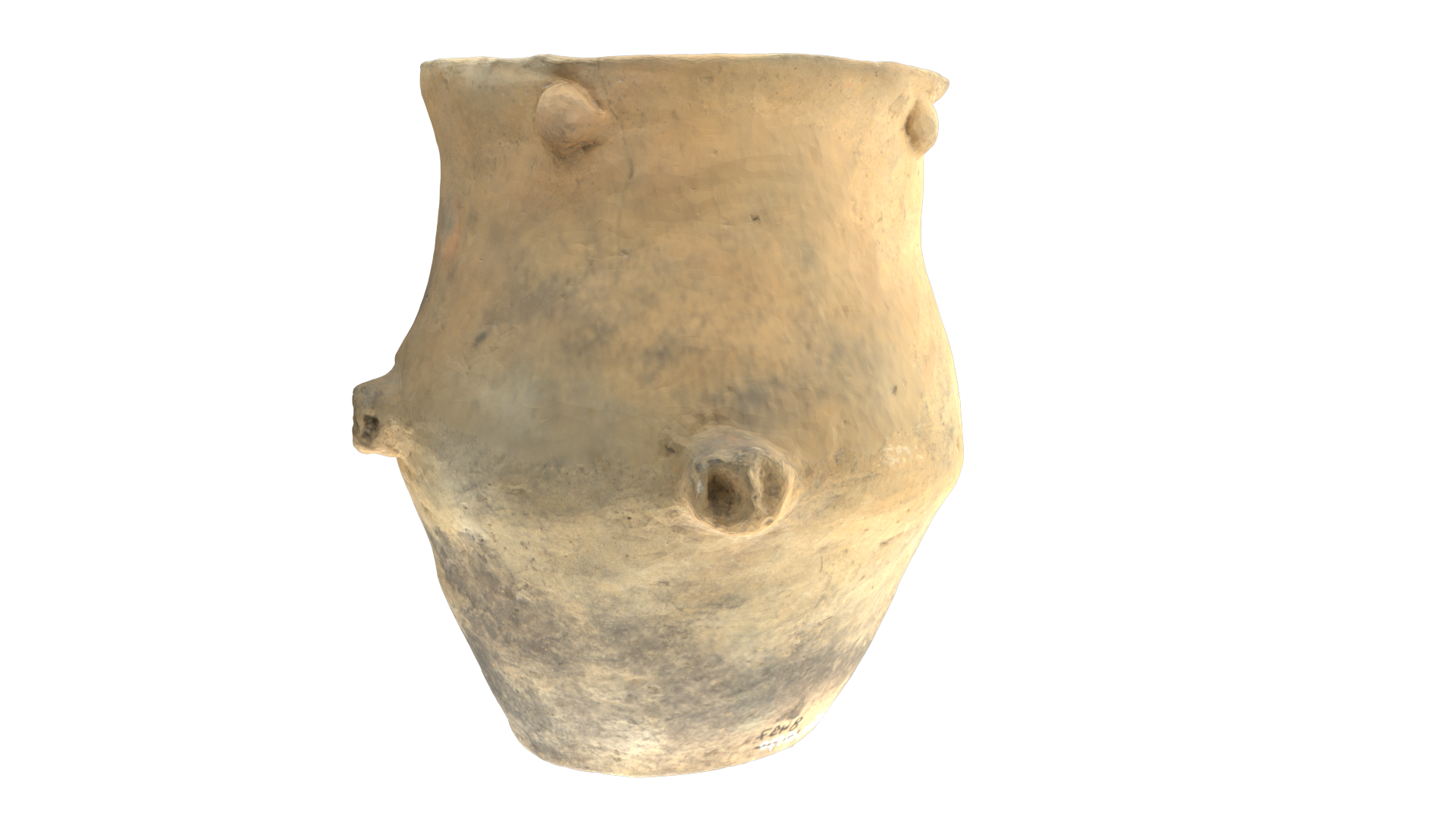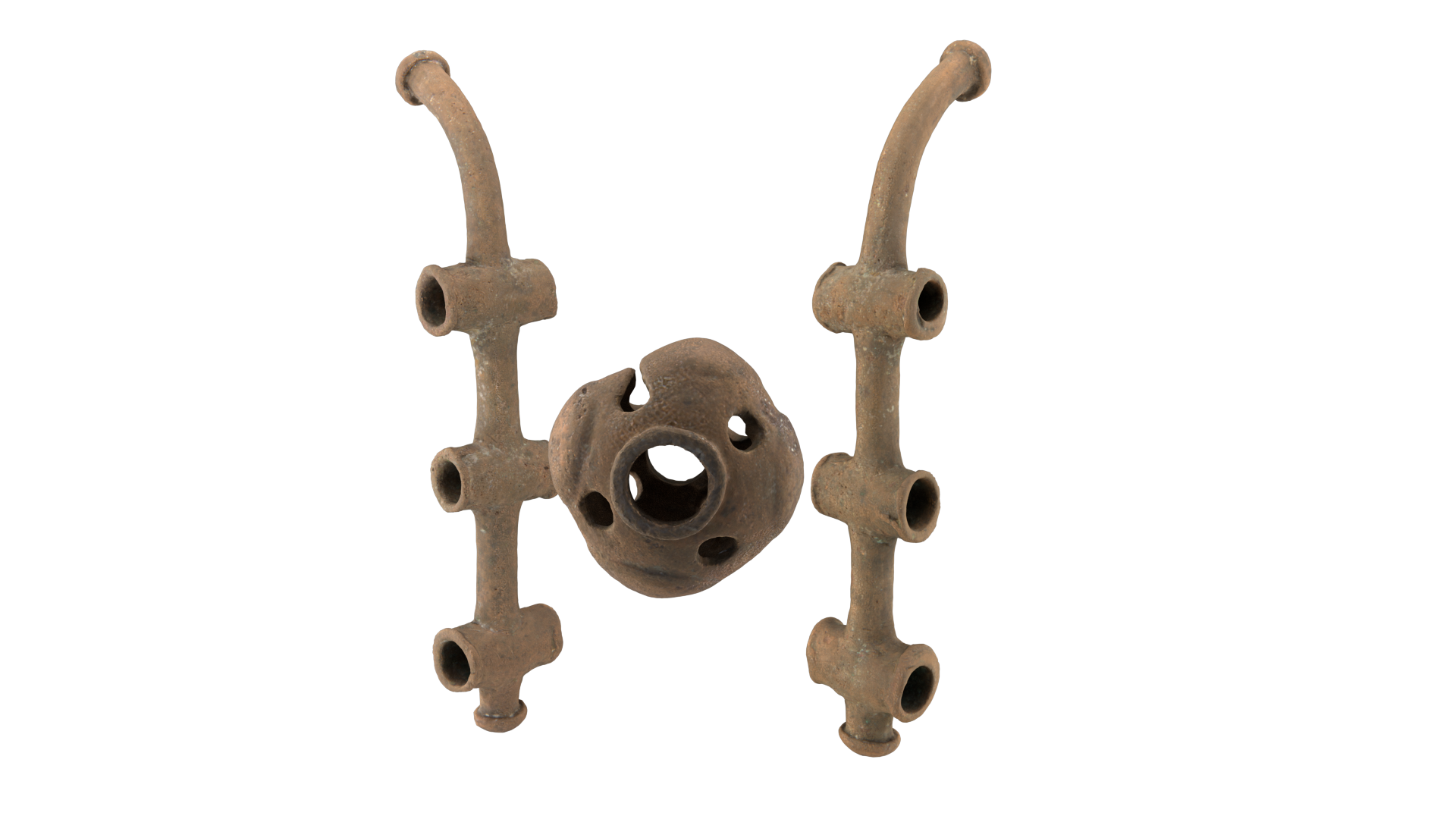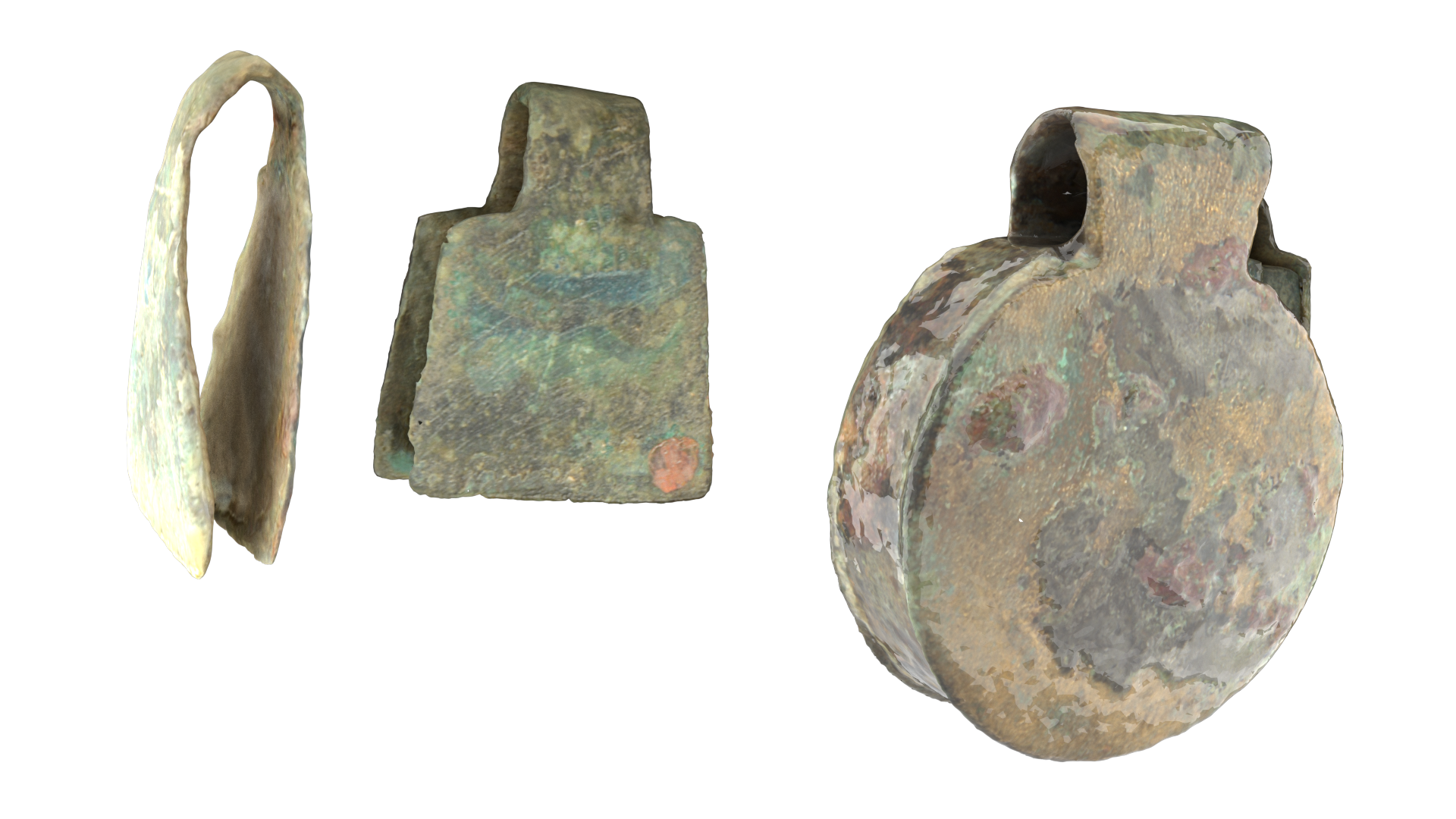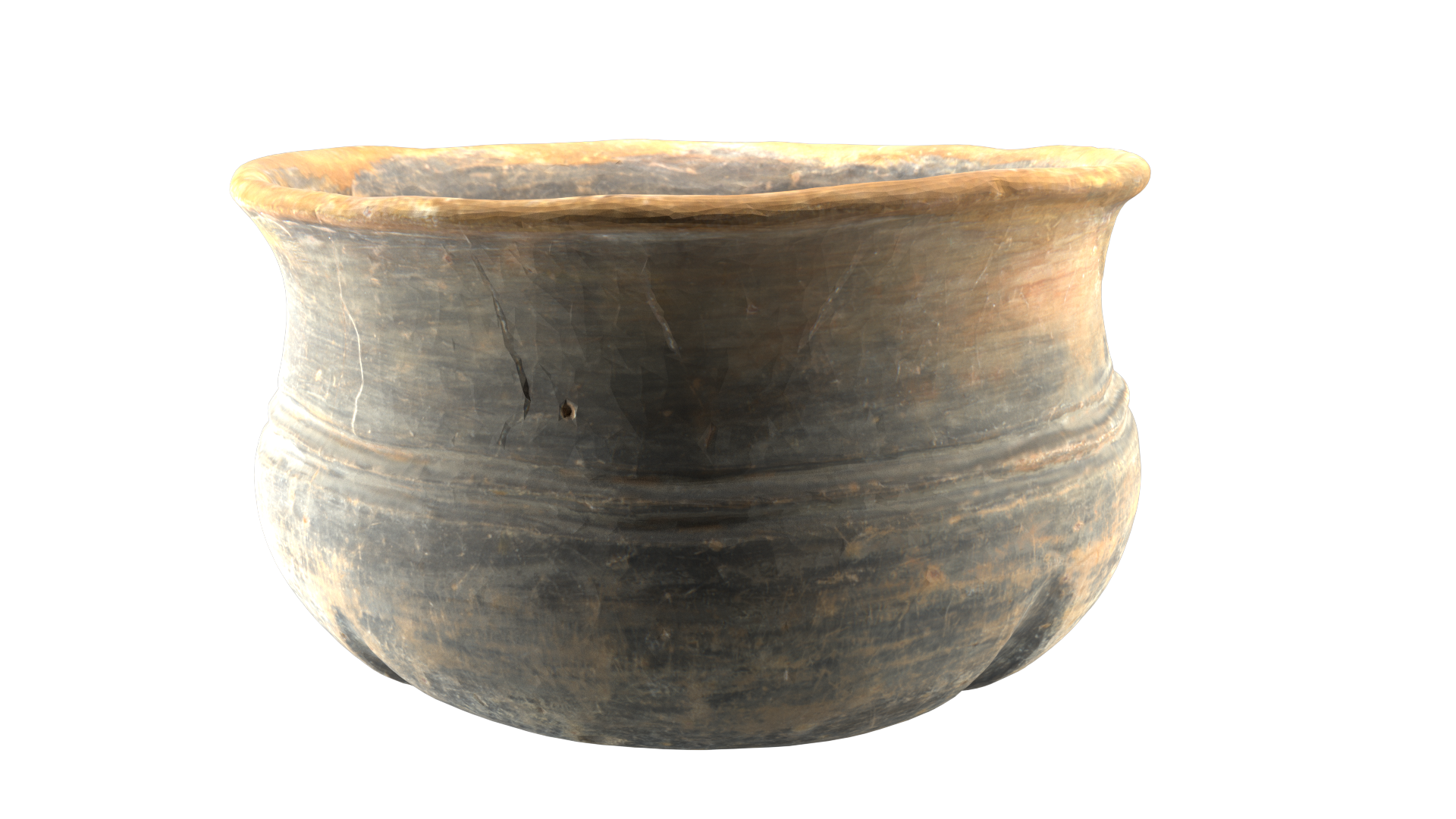Archaeological Exhibition
The town of Senica has been situated at the crossroads of trade routes since prehistoric times. From north to south, the Amber Road ran along the Morava River, while from west to east, a trade route known in the Middle Ages as the Czech Road crossed the region. Thanks to its strategic location at the intersection of these important routes, archaeological findings confirm continuous settlement throughout all periods of human history.
Mammoth Tusk Fragment
Old Stone Age – Paleolithic (500,000 – 8,000 BC)
Findspot: Kunov Reservoir
During the Old Stone Age, the first humans inhabited the area of present-day Senica, as confirmed by archaeological research in Kunov and Čáčov. Both anatomically modern humans (Homo sapiens sapiens) and our closest "cousin," the Neanderthal (Homo sapiens neanderthalensis), hunted the so-called Ice Age megafauna — giant animals such as the woolly mammoth, woolly rhinoceros, and cave bear. Evidence of this hunting activity includes the discovery of a fragment of a woolly mammoth tusk, found during the construction of the Kunov Reservoir.
Mammoth Tooth
Old Stone Age – Paleolithic (500,000 – 8,000 BC)
Findspot: Kunov Reservoir
Finds from the oldest and longest period of human history — the Paleolithic — are often buried deep beneath layers of yellow loess. Archaeological objects from this period are therefore typically discovered during large-scale excavation works, such as the construction of the present-day Kunov Reservoir. In 1961, Paleolithic sites were uncovered during the building of the dam. A worker discovered a tooth (a molar) of a smaller woolly mammoth (Mammuthus primigenius), which later became part of the collection of the Friends of History Club.
Dimensions: approximately 20 × 10 × 10 cm
Collection of Stone Tools
Middle Stone Age – Mesolithic and New Stone Age – Neolithic (two periods)
8,000 – 4,400 BC
Findspot: Kunov
Around 11,600 years ago, changing environmental conditions marked the end of the Ice Age. This transition ushered in the Mesolithic period, followed by the Neolithic with the arrival of the first farmers. Knappable stone remained the primary material for producing sharp tools. A representative example is a collection of stone tools from Kunov, found at a site known as Záhrobové diely.
This set includes a stone core from which blades were detached and then mounted onto wooden or bone handles. These tools served as cutting implements — blades, scrapers, and burins (engraving tools).
Stone Axe
New Stone Age – Neolithic (5,600 – 4,400 BC)
Findspot: Senica
By the middle of the 6th millennium BC, the first farmers belonging to the Early Linear Pottery Culture settled in the Senica region. These were the first people to adopt a sedentary lifestyle, beginning to shape and transform their environment. This new way of life required the development of new stone tools.
Stone axes were fitted into wooden handles and used in much the same way as axes today — primarily for chopping wood.
Stone Axe with a Perforation
New Stone Age – Neolithic (5,600 – 4,400 BC)
Findspot: Kunov
The shift to a sedentary lifestyle during the Neolithic period not only improved living conditions and led to population growth, but also sparked the development of new technologies.
A remarkable example of the technical skill of prehistoric people is this stone axe with a perforation, discovered in Kunov. The hole allowed the axe to be securely mounted onto a wooden handle, increasing its effectiveness and durability.
Loom Weights and Spindle Whorls
New Stone Age – Neolithic (5,600 – 4,400 BC)
Findspots: Senica, Kunov, Sotina
A settled way of life was closely linked to the development of crafts. Among the finds from Senica are textile-related artifacts such as loom weights and spindle whorls, used for weaving flax, nettle fibers, and even animal hair.
Archaeological excavations in Senica, Sotina, and Kunov have revealed traces of textile production. The spindle whorl was fitted onto a spindle, which was then used to spin the thread. Rectangular loom weights served to secure the warp threads on the loom, allowing the weaving process to take place.
Neolithic Pottery Vessel
New Stone Age – Neolithic (5,600 – 4,400 BC)
Findspot: Čáčov
From the Neolithic period onwards, archaeological sites show clear evidence of material culture through the presence of pottery vessels. Prehistoric communities not only produced pottery but also decorated it in various ways, with styles evolving over time.
For archaeologists, pottery is a valuable source of information, helping to classify past populations into distinct archaeological cultures. Pottery also provides more precise dating than stone tools alone.
This vessel belongs to the Early Linear Pottery Culture, marking some of the earliest evidence of permanent settlement in the area of present-day Senica.
Clay “Lamp”
Late Stone Age – Eneolithic (4,400 – 2,300/2,200 BC)
Findspot: Kunov, Záchrastie area
In the Early Eneolithic period (after 4,400 BC), the area of present-day Senica was inhabited by people of the indigenous Neolithic Lengyel Culture.
A notable find from this period is a square-shaped ceramic object discovered in Kunov. Such objects are commonly interpreted as either primitive lamps or as containers designed to safely store materials that needed to be kept sealed.
Eneolithic Pottery Vessel
Late Stone Age – Eneolithic (4,400 – 2,300/2,200 BC)
Findspot: Čáčov
A distinctive feature of the Lengyel Culture is its richly painted pottery, which is why it is often referred to in neighboring Moravia as the Painted Pottery Culture. However, for everyday life, people produced more modest and functional ceramic vessels.
An example of such utilitarian pottery is this vessel from Čáčov.
Dimensions: approximately 20 × 20 × 30 cm
Bronze Pin
Bronze Age (2,300/2,200 – 800 BC)
Findspot: Čáčov
During the Bronze Age, people fastened their garments using bronze pins, which served both practical and decorative purposes. As with modern fashion, these pins changed over time — varying in shape and ornamentation.
An example of such a garment fastener is this bronze pin discovered in Čáčov.
Velatice Culture Pottery Vessel
Bronze Age (1,250 – 1,000 BC)
Findspot: Senica
The presence of numerous Bronze Age archaeological cultures has been confirmed in Senica and its surroundings. One example is this vessel from the Late Bronze Age, crafted by people of the Velatice Culture.
Dimensions: approximately 10 × 10 × 10 cm
Bronze Fitting from a Horse Harness
Period: Late Bronze Age (800 – 750 BC)
Findspot: Senica – Kolónia
Between 800 and 750 BC, nomadic populations from the steppes north of the Black Sea began to enter the Senica region. Among them were the Cimmerians, a warrior people known for their skilled horseback riding and archery. Driven westward by pressure from tribes of the Caucasus, the Cimmerians expanded not only into Europe but also towards the Eastern Mediterranean, where their raids are even recorded in written sources.
The Cimmerians can be identified both through distinctive elements of their material culture and by their name, which appears in ancient records. On the territory of present-day Slovakia, only a few Cimmerian artifacts have been discovered, making the find from Senica one of the most significant.
In 1942, during the construction of workers' housing for a chemical fiber factory (later known as Slovenský hodváb) — in the area today called Kolónia — several graves and a furnace were disturbed. Unfortunately, due to the absence of a proper archaeological excavation, the exact number of graves remains unknown.
Golden Diadem
Period: Late Bronze Age (800 – 750 BC)
Findspot: Senica – Kolónia
In addition to the horse harness fitting, the 1942 discoveries in the Kolónia area also included an iron knife, pottery, and — most remarkably — a diadem made of thin gold sheet, found resting on a human skull. According to records, the find originally also included a gold ring, which has since been lost.
Shortly after its discovery, the diadem was cut into 40 pieces, and it was not until the 1960s that efforts to reassemble it began. Despite these efforts, at least 19 pieces of the diadem remain missing.
The displayed replica of the golden diadem from Senica shows how the original might have looked. Due to its delicate thickness, the diadem was likely reinforced with textile or another organic material, which has not survived.
Roman Brooch
Roman Period – 2nd century AD
Findspot: Čáčov
In 1937, archaeologist Viktor Šemmer investigated a multi-period archaeological site at Beňovský Gravel Pit in Čáčov (present-day football field). Among the findings was the grave of a wealthy Germanic woman. Unfortunately, the skeleton was not excavated, preventing an anthropological study that could have clarified several uncertainties about the burial.
The woman’s clothing was fastened with a Roman brooch. In archaeological terminology, it is a bronze brooch, silver-plated, with a broad, profiled bow and a central rib decorated in relief.
Roman Decorative Pendants
Roman Period – 2nd century AD
Findspot: Čáčov
A member of the wealthy Germanic elite buried at this site was adorned not only with a brooch but also with bronze pendants, some bearing traces of silver plating, which decorated his or her garments.
The significance of this grave lies particularly in the discovery of remnants of what was likely Chinese silk, preserved as imprints on a ring and an iron pendant made from a seashell (Cypraea pautherina) believed to have originated from Egypt.
This remarkable find demonstrates the interconnectedness of the ancient world — not only within the vast Roman Empire and the neighboring Germanic barbaricum but also through the Silk Road, which linked these distant regions with faraway China.
Germanic Pottery
Roman Period – 2nd century AD
Findspot: Čáčov
During the Roman Period, Germanic tribes inhabited the valley of the Teplica River. Their presence is evidenced not only by elite burials, such as the rich grave discovered in Čáčov, but also by numerous everyday finds of Germanic pottery fragments scattered throughout the Teplica basin.
Compared to Roman imported vessels, Germanic pottery was generally of lower quality. However, two completely preserved Germanic cups, uncovered at the Beňovský Gravel Pit in Čáčov, provide valuable insight into the daily life and material culture of these communities.
Germanic Pottery
Roman Period – 2nd century AD
Findspot: Čáčov
During the Roman Period, Germanic tribes inhabited the valley of the Teplica River. Their presence is evidenced not only by elite burials, such as the rich grave discovered in Čáčov, but also by numerous everyday finds of Germanic pottery fragments scattered throughout the Teplica basin.
Compared to Roman imported vessels, Germanic pottery was generally of lower quality. However, two completely preserved Germanic cups, uncovered at the Beňovský Gravel Pit in Čáčov, provide valuable insight into the daily life and material culture of these communities.
Slavic Pottery
Early Middle Ages – 7th to 8th century AD
Findspot: Senica
Early Slavic settlement in the area of Senica has been confirmed at several sites. Archaeologists have uncovered settlement structures, such as typical Slavic semi-sunken dwellings, and pottery belonging to the Prague-type tradition.
A characteristic example is a vase-shaped vessel with a slightly flared rim, found on the Čáčov Road. Early Slavic pottery was originally undecorated, but from the 7th century AD onwards, incised decorations such as wavy lines and horizontal bands began to appear.


